MICRO CREDIT REVOLVING FUND DISTRIBUTION
Mobilizing capital to procure livestock by the poor farmers is exceedingly difficult especially in the wake of the pandemic. To assure them procure livestock we planned the revolving fund, with the support of “ITALIAN BISHOPS CONFERENCE” – ROME. The beneficiaries were identified through home visits and formation of Self-Help Groups in order to ensure group learning, cooperation, and accountability among the group members.
The selection was confined to the following categories:
- Dalits/Tribal/Migrants family members who are left behind.
- Famers with less than 1 hectare of land.
- Single women.
- Families with women as bread winners.
- Widows and deserted women.
- This scheme relieved people from the trap of high interest lending money lenders.
- There is a positive shift in the economy of the marginal farmers. There is a slight increase in their average income.
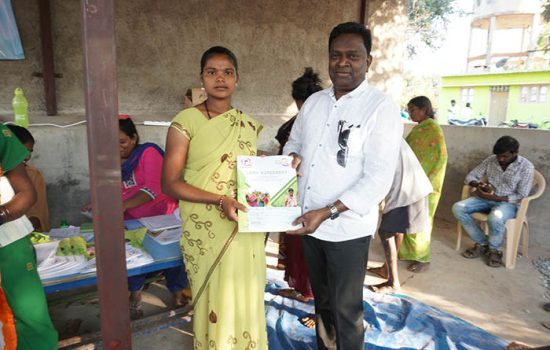
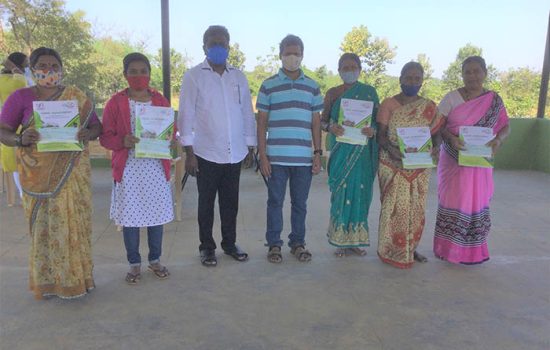
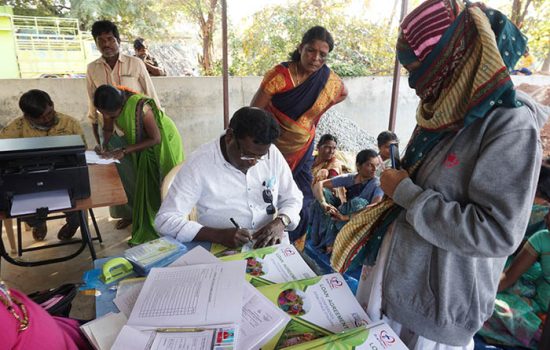
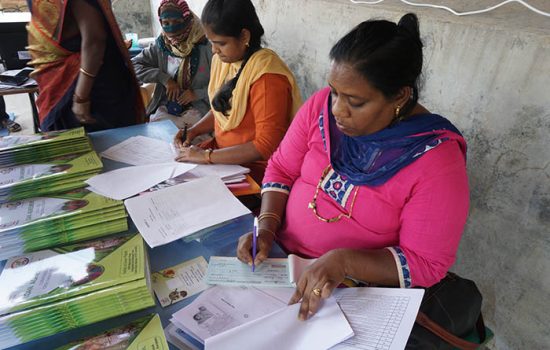
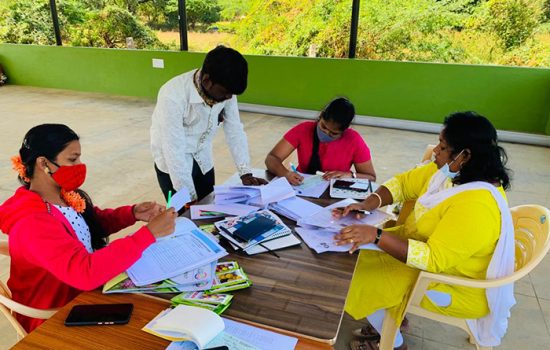
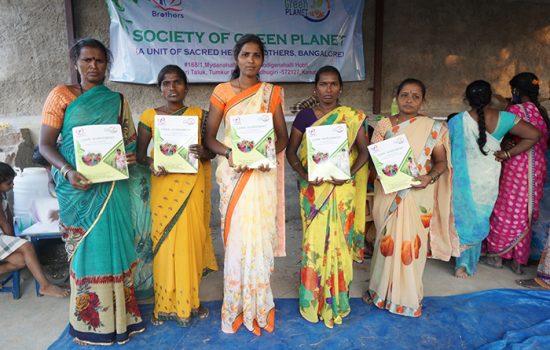
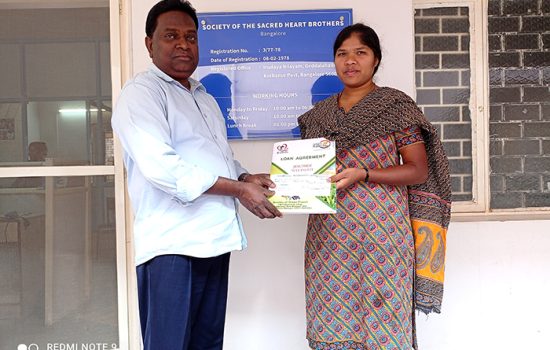
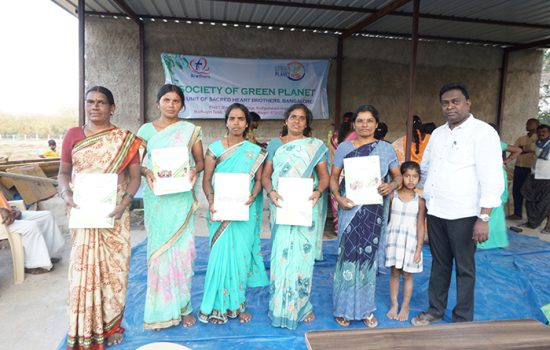
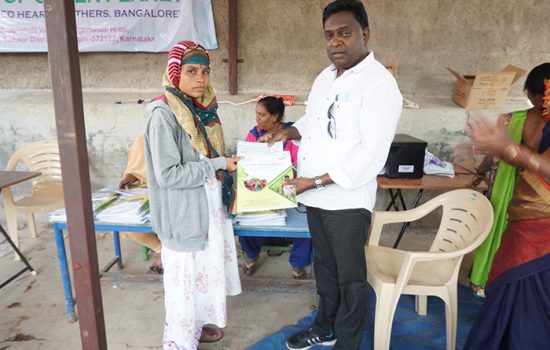

S.No | Date | Number of Beneficiaries | Loan Issued | |
Per Head | Total Amount | |||
1. | 04-03-2021 | 43 | 15,000.00 | 6,45,000.00 |
2. | 17-03-2021 | 35 | 15,000.00 | 5,25,000.00 |
3. | 19-03-2021 | 34 | 20,000.00 | 6,80,000.00 |
4. | 27-07-2021 | 29 | 25,000.00 | 7,25,000.00 |
5. | 01-09-2021 | 2 | 20,000.00 | 40,000.00 |
6. | 21-01-2022 | 24 | 15,000.00 | 3,60,000.00 |
7. | 16-09-2022 | 5 | 15,000.00 | 75,000.00 |
8. | 16-02-2023 & 19-05-2023 | 2 | 30,000.00 | 60,000.00 |
9. | 07-06-2023 | 30 | 20,000.00 | 6,00,000.00 |
10. | 18-08-2023 | 6 | 20,000.00 | 1,20,000.00 |
11. | 15-10-2023 | 21 | 20,000.00 | 4,20,000.00 |
GRAND TOTAL | 42,50,000.00 | |||
- This scheme provides social security to their families especially for children’s education, healthy foods, women’s empowerment, and others.
- The villagers, especially beneficiaries, are now introduced into phone banking.
- The villagers are encouraged to take up this scheme as it is easy to apply for loan with PAN, Aadhaar, Bank Passbook and Ration ID.
- Providing loans to women’s who traditionally face more challenges in accessing financial services, this scheme helps them to be the decision makers, economically independent and overall well-being.
- There is a social development in fostering community cohesion. It has promoted collective action and encourages collaborative efforts among farmers.
- There is a development in local markers and value chains. This contributes to economic growth and overall community development.
FIELD VISITS, TRAINING & EXPOSURES
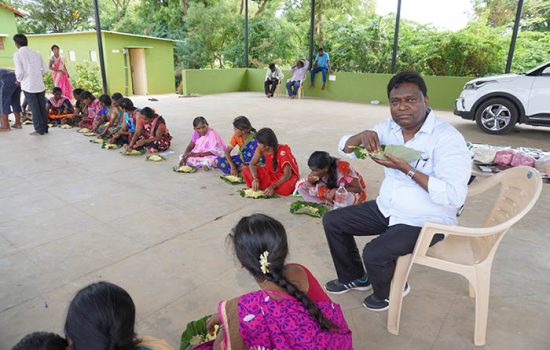

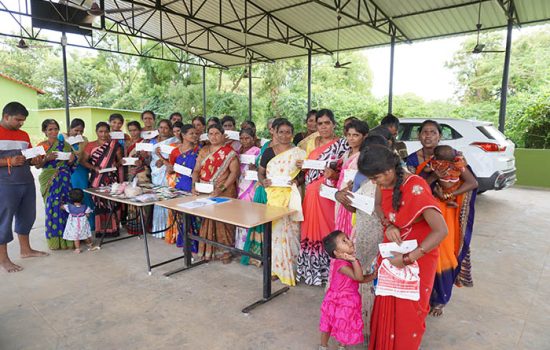
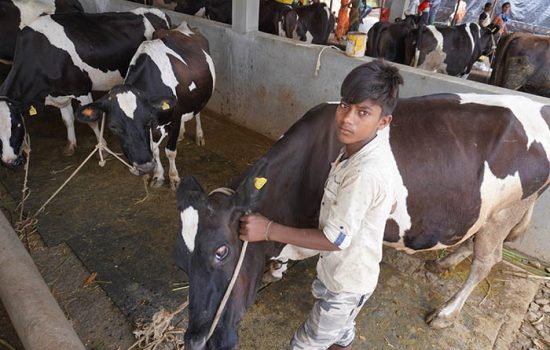
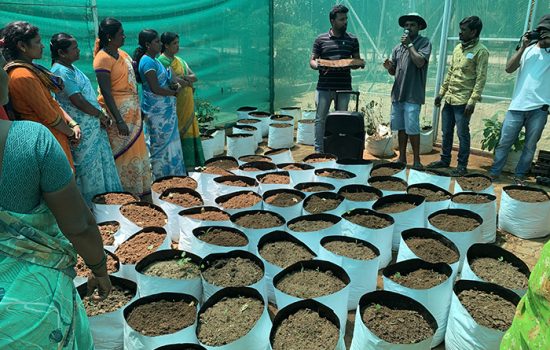

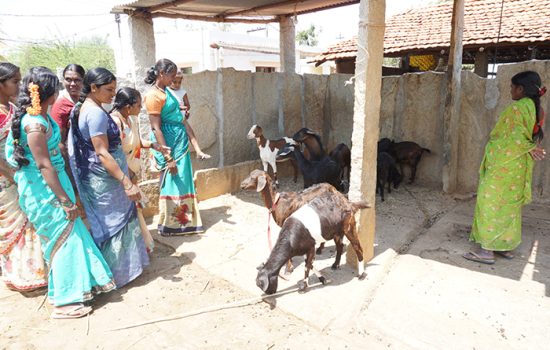
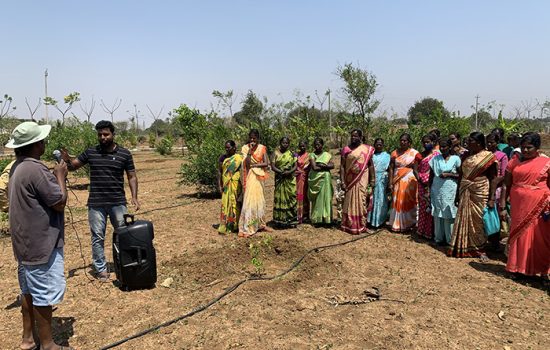

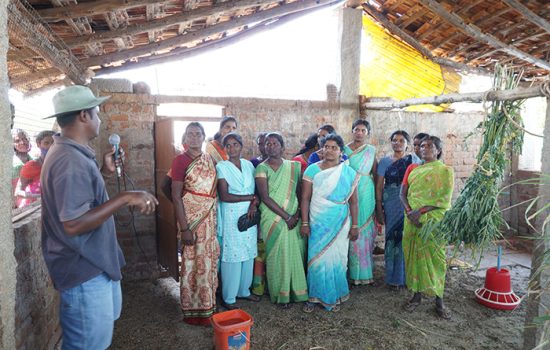
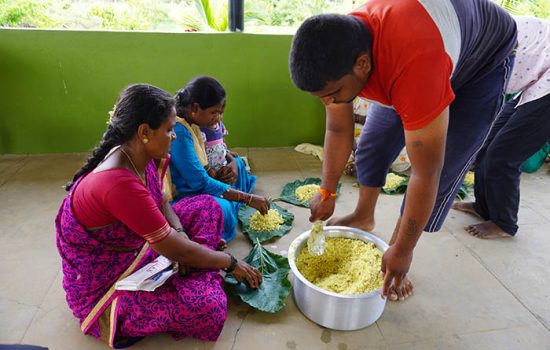
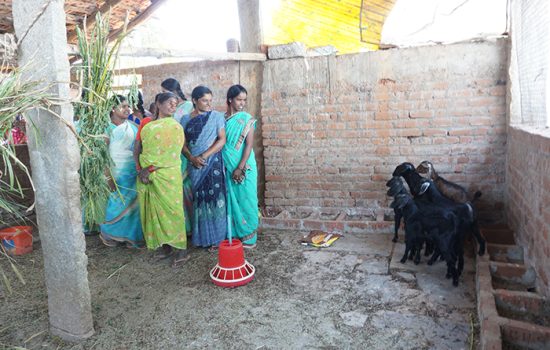
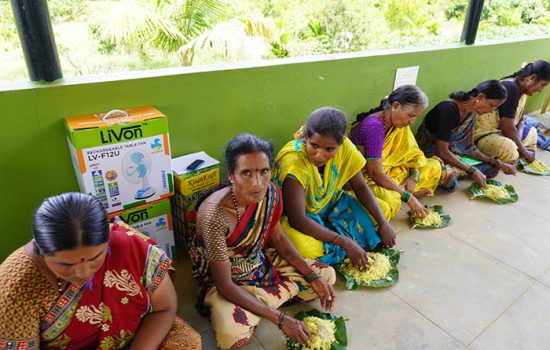
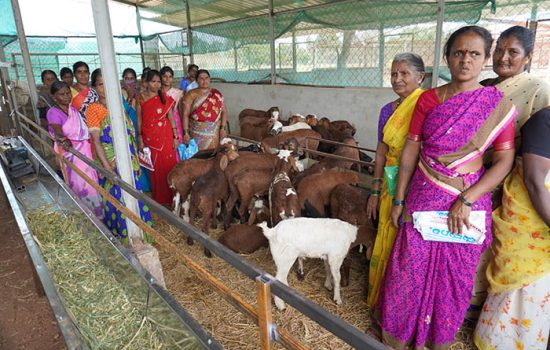

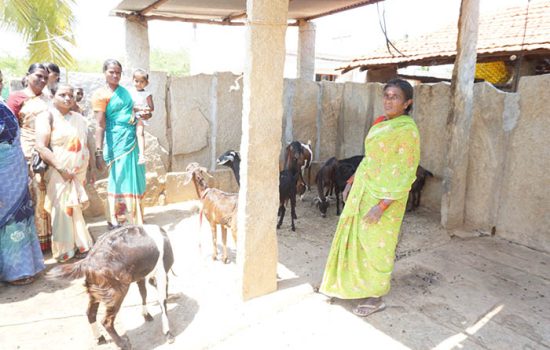

S. No | Date | Theme | No. of Participants |
1. | 14.02.2021 | On Field Training for Farmers | 35 |
2. | 23.08.2021 | Hands on Experience and Monitoring | 25 |
3. | 08.12.2021 | Field Visit, Monitoring, And Exposure | 25 |
4. | 21.12.2022 | Workshop on Integrated Farming & Livestock Development | 45 |
5. | 26.03.2023 | Workshop on Cattle Management & Insurance | 50 |
6. | 15.04.2023 | Workshop on Rainwater Harvesting | 30 |
7. | 07.06.2023 | Field Visit, Monitoring, And Exposure | 30 |
8. | 13.12.2023 & 14.12.2023 | Empowering women entrepreneurs in sustainable product training and self-employment | 35 |
- Increased awareness in Farmer education programs such as sustainable farming methods, efficient water management, pest and disease management, and the use of technology. Accessible information channels, including helplines, toll-free numbers, or mobile apps that can be used for guidance.
- Setting up the demonstration Farms in the village helped the marginalized farming communities practice successful agricultural practices. They learn from real-life examples. The demonstration primarily focuses on organic farming, sustainable water management, and high-yield crop varieties suitable for this region. The suitable crops include tomatoes, papaya, chiles, and others.
- Key factors such as access to land (protection of land rights, long-term planning), financial inclusion (saving accounts, credit facilities, insurance), market Linkages (knowing market demands, direct market access), irrigation and water management (such as canals, wells, or micro irrigation systems), technology adoption (improved seeds, mechanization, farming techniques), social safety nets (insurance schemes, support initiatives), and others give a positive outlook to their farming activities.
- Mydanahalli is located 1371 km north of the equator and 8280 km east of the prime meridian. The climate conditions are dry, humid, and sunny. The average rainfall is 739.6 mm, and in 2016, the actual rainfall was 412.1mm. Most of the soil type is red. The recommended horticulture crops are coconut, arecanut, banana, mango, sapota, pomegranate, tomato, brinjal, chilly, and so on.
- The red soil is found in subtropical regions and is characterized as low-fertile soil. So, the land is treated with manure, such as Farmyard manure, which is called compost. This is prepared by decomposing a mixture of animal dung, crop residues, and other organic waste. It improves soil structure, enhances water-holding capacity, adds organic matter, and provides essential nutrients like nitrogen, phosphorus, and potassium.
- Green manure fixes atmospheric nitrogen into the soil, improves soil fertility, and adds organic matter when plowed under.
- Poultry manure is a rich source of nutrients, particularly nitrogen and phosphorus. It can be applied to red soil to supplement the nutrient content and improve soil fertility. However, poultry manure should be properly composted or aged before application to prevent burning or nutrient imbalances.
- Neem cake is a byproduct obtained from the seed kernels of the neem tree. It is rich in organic matter and contains natural compounds that have insecticidal and nematicide properties. Neem cake can be incorporated into red soil to improve soil fertility, control pests, and enhance plant growth.
ESTABLISHMENT OF DEMONSTRATION FARM
- The village of Mydanahalli has a population of around 3000 people. Around 338 families live there. The village is underdeveloped, and the main occupation of the villagers is agriculture. Their livelihood is based on agriculture, cattle rearing, poultry, dairy production, and others.
- Establishment of a demonstration farm in the village, which has a high number of marginal farmers, can improve the economy of the village and make it self-sufficient. The average income of a person and per capita income will increase. Eradication of poverty and per capita consumption will increase. This also contributes to a positive shift in the overall GDP rate of the country.
- Demonstrating farm practices allows experienced farmers, agricultural experts, or extension workers to share their knowledge and expertise with marginal farmers, which provides a platform for practical learning where farmers can observe and understand the techniques, methods, and technologies being demonstrated. This direct transfer of knowledge can help farmers improve their understanding of effective farming practices.
- Marginal farmers develop practical skills and gain confidence in adopting new techniques. They learn about proper seed selection, planting methods, crop management practices, irrigation techniques, pest and disease control measures, and other aspects of sustainable farming. Developing these skills can contribute to improved agricultural productivity and income generation.
- Demonstrations showcase best practices in agriculture, including innovative and successful farming methods. The farmers observation of the benefits and results of these practices results in them adopting the techniques on their own farms. Demonstrations serve as powerful motivators for marginalized farmers to implement improved techniques that can lead to increased yields, reduced costs, and overall improved farm management.
- Through demonstrations, the farmers interact with the experts directly and discuss specific challenges they face on their farms. Experts provide practical solutions and suggestions based on the local context, resources, and constraints. This direct interaction allows for personalized guidance and problem-solving, addressing the specific needs of marginal farmers.
- Demonstrations include the use of modern agricultural technologies and machinery, and after witnessing the benefits of such technologies, marginalized farmers may be more willing to adopt them on their own farms. This has led to increased efficiency, reduced labour requirements, and improved productivity.
- Demonstrations empower marginal farmers by building their knowledge, skills, and confidence in their farming abilities. Seeing successful practices and results in their own village or nearby areas gives them a sense of confidence in their own potential for success. It motivates them to take risks, try new techniques, and adopt innovative farming methods.
SUPPLY OF AGRO INPUTS
- The main source of information is from “How to Raise a Plant Baby,” a beginner’s guide to happy plants by Vinayak Garg. It’s a delightful and informative book that serves as an excellent resource for both beginners and experienced plant enthusiasts. This book basically provides guidance on a comprehensive overview of caring for indoor plants and ensures that even the most inexperienced individuals can successfully nurture their green friends.
- We have referred to the main content, which emphasizes the plants wellbeing and fostering a deeper connection with nature, the basics, and explores the therapeutic benefits of having plants. We also discuss the importance of mindfulness and attentive care for plants. The symbolic relationship between humans and nature is modified according to the rural area.
- The book includes practical tips on plant propagation, repotting, and dealing with pests and diseases. These sections provide invaluable guidance for plant lovers looking to expand their collection and troubleshoot common issues that may arise during their plant parenting journey.
- We have supplied the combined information to the marginal farmers through community workshops. Organizing community workshops conveys book information through live performances. Use interactive methods such as skits, role-plays, or puppetry to engage illiterate individuals and communicate the content effectively.
- In the future, we are planning to acknowledge people who use audiobooks. Convert books into audio format, either by recording narrations or using text-to-speech technology. Distribute these audio books through various means, such as CDs, USB drives, or digital platforms. Illiterate individuals can listen to the content and grasp the information effectively.
- Create pictorial versions of books that convey information through images, illustrations, and diagrams. These visual materials can be used to depict stories, explain concepts, or provide step-by-step instructions. The use of visual cues helps illiterate individuals understand and retain information.
- Use oral forms of communication, such as storytelling traditions, to convey book information. Skilled storytellers can narrate the content of books in an engaging and interactive manner, making them accessible and enjoyable for illiterate individuals. This method allows for cultural preservation and encourages community participation.
- The attention span of a human now is reduced from 12.0 seconds to 8.0 seconds. Produce videos or animated content that visually presents book information. Use simple language, visuals, and animations to explain concepts, tell stories, or provide educational content. These videos can be shared through DVDs, USB drives, or online platforms for easy access.
- Train literate individuals within the community to serve as peer educators. They can share book information with illiterate individuals through one-on-one interactions, group discussions, or community gatherings. Community leaders can also play a crucial role in disseminating book information and promoting its importance.
- Utilize mobile phones and messaging services to provide book information to illiterate individuals. Develop audio messages or voice-based platforms that deliver snippets of book content, educational materials, or storytelling sessions directly to their mobile phones.
- Display visual signage and posters in public spaces, community centers, or schools that depict important information from books. Use symbols, pictures, and simple text to convey key messages. This approach can help illiterate individuals acquire basic knowledge and awareness.
- These approaches are focused on inclusivity, engagement, and accessibility to ensure effective communication and understanding.
- Preparation and publication of printed material in local language – Kannada.
- Banners, handbills, posters and fliers were prepared and distributed.
- Individual files are maintained for each beneficiary.
- Audio visual aids are used for the training sessions.
- A portable loudspeaker is used for training sessions and field visits.
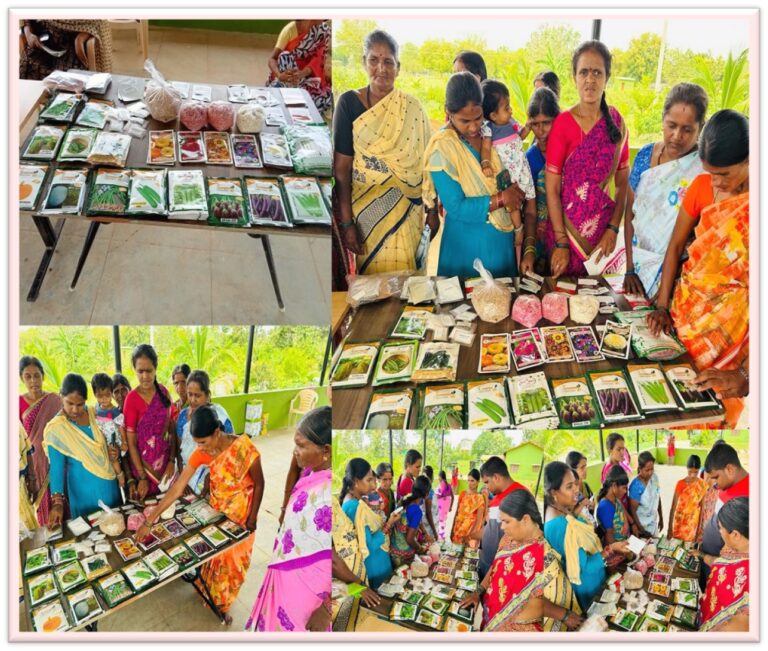
SUPPLY OF INFORMATION
- The main source of information is from “How to Raise a Plant Baby,” a beginner’s guide to happy plants by Vinayak Garg. It’s a delightful and informative book that serves as an excellent resource for both beginners and experienced plant enthusiasts. This book basically provides guidance on a comprehensive overview of caring for indoor plants and ensures that even the most inexperienced individuals can successfully nurture their green friends.
- We have referred to the main content, which emphasizes the plants wellbeing and fostering a deeper connection with nature, the basics, and explores the therapeutic benefits of having plants. We also discuss the importance of mindfulness and attentive care for plants. The symbolic relationship between humans and nature is modified according to the rural area.
- The book includes practical tips on plant propagation, repotting, and dealing with pests and diseases. These sections provide invaluable guidance for plant lovers looking to expand their collection and troubleshoot common issues that may arise during their plant parenting journey.
- We have supplied the combined information to the marginal farmers through community workshops. Organizing community workshops conveys book information through live performances. Use interactive methods such as skits, role-plays, or puppetry to engage illiterate individuals and communicate the content effectively.
- In the future, we are planning to acknowledge people who use audiobooks. Convert books into audio format, either by recording narrations or using text-to-speech technology. Distribute these audio books through various means, such as CDs, USB drives, or digital platforms. Illiterate individuals can listen to the content and grasp the information effectively.
- Create pictorial versions of books that convey information through images, illustrations, and diagrams. These visual materials can be used to depict stories, explain concepts, or provide step-by-step instructions. The use of visual cues helps illiterate individuals understand and retain information.
- Use oral forms of communication, such as storytelling traditions, to convey book information. Skilled storytellers can narrate the content of books in an engaging and interactive manner, making them accessible and enjoyable for illiterate individuals. This method allows for cultural preservation and encourages community participation.
- The attention span of a human now is reduced from 12.0 seconds to 8.0 seconds. Produce videos or animated content that visually presents book information. Use simple language, visuals, and animations to explain concepts, tell stories, or provide educational content. These videos can be shared through DVDs, USB drives, or online platforms for easy access.
- Utilize community radio or podcast platforms to deliver book information. Produce audio programs that summarize book content, discuss key points, or share stories from books. These programs can be broadcast regularly, allowing illiterate individuals to listen and gain knowledge.
- Train literate individuals within the community to serve as peer educators. They can share book information with illiterate individuals through one-on-one interactions, group discussions, or community gatherings. Community leaders can also play a crucial role in disseminating book information and promoting its importance.
- Utilize mobile phones and messaging services to provide book information to illiterate individuals. Develop audio messages or voice-based platforms that deliver snippets of book content, educational materials, or storytelling sessions directly to their mobile phones.
- Display visual signage and posters in public spaces, community centers, or schools that depict important information from books. Use symbols, pictures, and simple text to convey key messages. This approach can help illiterate individuals acquire basic knowledge and awareness.
- These approaches are focused on inclusivity, engagement, and accessibility to ensure effective communication and understanding.
- Preparation and publication of printed material in local language – Kannada.
- Banners, handbills, posters and fliers were prepared and distributed.
- Individual files are maintained for each beneficiary.
- Audio visual aids are used for the training sessions.
- A portable loudspeaker is used for training sessions and field visits.
SUPPLY OF VERMI WORMS AND HERBAL PEST REPELLENTS
- Most small farmers / households use their available little space of their backyard for vermicompost in the traditional way.
- Pit method is rather expensive and not very prominent in the villages since it involves cemented pits. Poor aeration and water logging is a problem in this method.
- Using kitchen waste and other green waste
- This manure is rich and nutrient with micro-organisms.
- Bed compost method is popular in the villages using cow dungs, green waste, vegetable waste.
- But the problem is choice of place for bedding, use of right worms and moistening.
- Production of quality product is a challenge in a waste competitive market.
- Logistics and marketing are foreseen as a challenge from this remote village.
- We have regulated the supply of vermiworms. Vermiworms, also known as earthworms, are used for vermicomposting and offer several advantages in rural farming in India. Vermiworms are excellent decomposers that can efficiently convert organic waste into nutrient-rich vermicompost.
- In the village of Mydanahalli, where agricultural waste and organic materials are abundant, vermiworms provide a sustainable and eco-friendly solution for waste management on farms. This helps reduce the accumulation of organic waste and its negative impact on the environment. The negative impact on the environment includes pollution, deforestation, which triggers climate change, soil erosion, poor air quality, and undrinkable water.
- Vermicompost, produced by vermiworms, is a potent organic fertilizer. The compost we supply contains high levels of beneficial microorganisms, plant nutrients, and organic matter. When added to the soil, it enhances soil structure, improves water retention, and increases nutrient availability for plants. This leads to healthier and more fertile soil, which is crucial for productive farming in rural areas.
- Vermicompost serves as a low-cost alternative to synthetic fertilizers. It helps the villagers by limiting their financial expenditures on synthetic fertilizers. Vermiworms provide a sustainable option for farmers to produce their own organic fertilizer. By utilizing vermicompost, farmers have reduced their dependence on expensive chemical fertilizers, leading to cost savings in the long run.
- The nutrient-rich vermicompost produced by vermiworms has promoted better plant growth, increased crop yields, and improved overall plant health. We have seen good results by using vermicompost. It stimulates root development and provides a favorable soil environment for beneficial soil organisms.
- The farmers have benefited from improved productivity and profitability using vermicompost. This is a very beginning step for the marginal farmer to have a stable economy.
- We have observed that after using vermicompost, it has contributed to the enhancement of soil biodiversity. As they burrow through the soil, vermiworms improve soil aeration and increase microbial activity, creating a healthier and more balanced soil ecosystem.
- We derive our Herbal pest repellents from natural plant-based ingredients, which makes them a more sustainable and eco-friendlier alternative to synthetic chemical repellents. It is basically biodegradable and has a minimal impact on the environment; it has reduced the risk of soil, water, and air pollution.
- We prefer Herbal pest repellents because they are considered safer for human health compared to synthetic chemical repellents. They are typically non-toxic or have low toxicity levels, reducing the risk of harmful effects on farmers, farm labourers, and consumers. This is particularly important in rural areas where farmers may have direct exposure to pesticides during application.
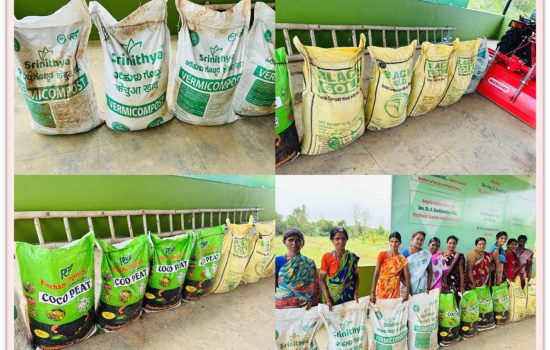
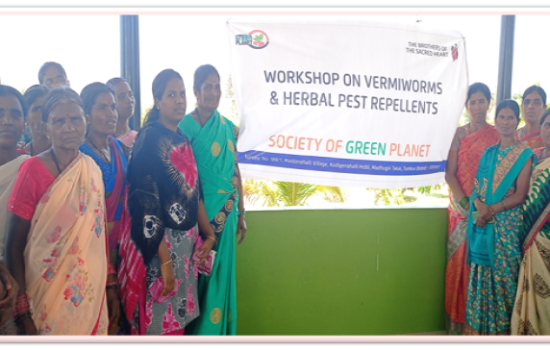
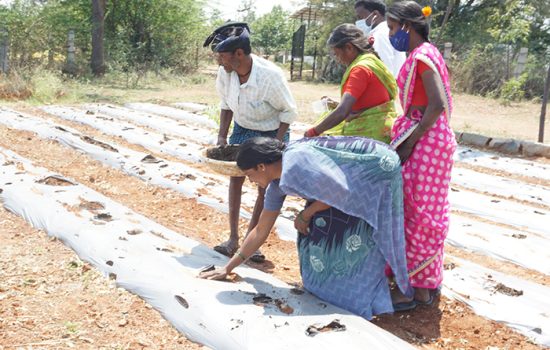
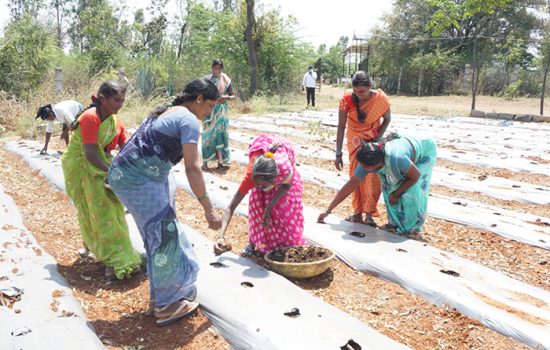
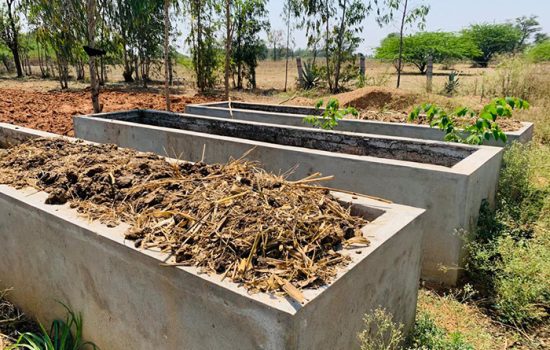
SUPPLY OF SAPLINGS AND HORTICULTURAL PLANTS
- We have supplied watermelon green, yellow fruit, cape gooseberry, lavender herb, asparagus, Capsicum orange, alpine strawberry, long tomato, cabbage red, Pak choy, broccoli, cherry red tomato, peppermint, tomato round hybrid, red radish, watermelon black, red fruit, squash, lettuce, muskmelon, ladyfinger, Brussels sprouts, brinjal, rosemary, basil Thai, and others.
- Red soil is typically characterized by good drainage and moderate fertility. Cape gooseberry plants generally prefer well-drained soils to avoid waterlogging, which can cause root rot.
- Red soil often tends to be acidic; the pH of the soil ranged between 6.0 and 7.0. We adjust the soil according to our preferred pH range. We assessed the soil’s fertility, drainage, and nutrient content before cultivating watermelons. Watermelons generally prefer well-drained soil with good fertility and organic matter content, so we adjusted the soil health accordingly.
- Asparagus (Asparagus officinalis) is specifically characterized by its red soil, such as its texture, nutrient content, and organic matter, which should be considered to ensure optimal growing conditions for asparagus.
- Capsicum generally grows in the pH range of 6.0 to 6.8. Red soil, which is typically rich in iron and other minerals, can provide good nutrient content for plant growth.
- Alpine strawberries (Fragaria vesca), also known as wild strawberries, can generally grow well in a variety of soil types, including red soil. Alpine strawberries prefer slightly acidic to neutral soil with a pH range of 5.5 to 7.0.
- Long tomato varieties can generally grow well in red soil and humid places. Red soil is often fertile and provides good nutrient content for plant growth.
- Red cabbage can tolerate a wide range of soil types, including red soil. Red cabbage prefers slightly acidic to neutral soil with a pH range of 6.0 to 7.0.
- Pak choi (also known as bok choy or Chinese cabbage) can generally grow well in a variety of soil types, including red soil. Red soils are typically well-draining and fertile, which can be beneficial for growing Pak Choi. By implementing proper care and management practices, we increase the likelihood of successfully growing Pak Choi in red soil in a humid environment.
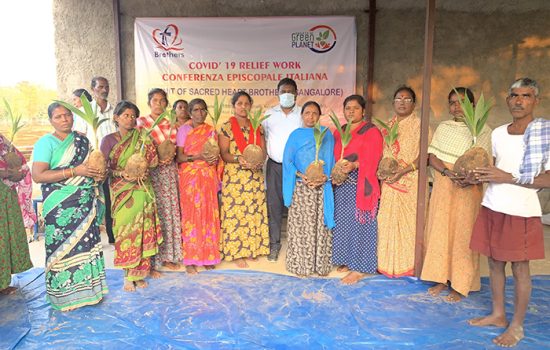
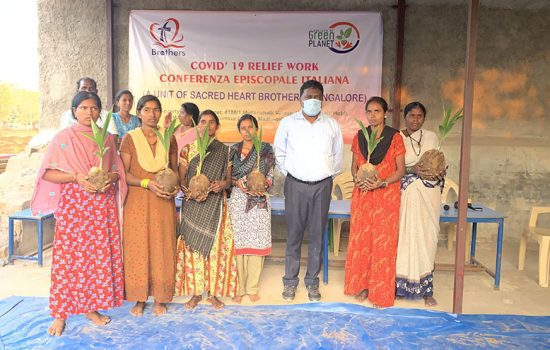
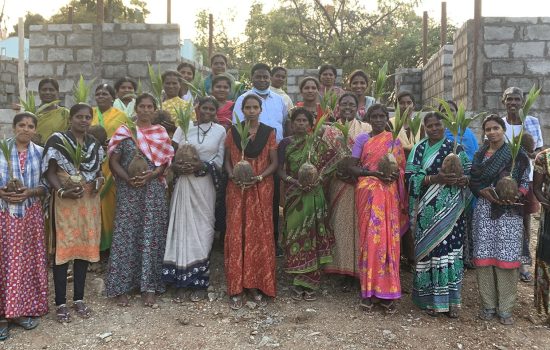
ESTABLISHMENT OF FARM PONDS
- The pond will provide a reliable and accessible water source for irrigation purposes. In a humid area like Mydanahalli with seasonal variations in rainfall, the pond helps the farmers store water during the rainy season and use it for irrigation during dry periods. We can see good results in the consistent water supply for crops, reducing dependence on rainfall, and increasing the reliability of agricultural activities.
- The pond will enable the farmers to diversify their agricultural activities by incorporating aquaculture. Fish farming in the pond can provide an additional source of income for farmers. Fish can be cultivated for personal consumption or for commercial purposes, contributing to food security and income generation.
- Ponds can also serve as a water source for livestock on the farm. Animals require water for drinking, and having a pond nearby can make it easier to provide them with a sufficient and convenient water supply. This improves the overall well-being and productivity of the livestock on the farm.
- Pond water can be utilized for nutrient recycling and enhancing soil fertility. Nutrient-rich water from the pond can be used for fertigation, where water-soluble fertilizers are applied through irrigation systems. This helps replenish essential nutrients in the soil, improving crop growth and yield.
- Ponds can have a positive impact on the microclimate of the surrounding area. The presence of water in the form of a pond can moderate temperature extremes and create a slightly cooler and more humid microclimate, which can be beneficial for some crops. It can help reduce heat stress on plants, especially during hot and dry periods.
- Ponds provide habitats for various plant and animal species, contributing to biodiversity conservation. They support a diverse range of aquatic organisms, including beneficial insects, amphibians, and water-dwelling organisms. These organisms can play important roles in natural pest control and pollination, benefiting the overall health of the ecosystem and ecological balance.
- We are ready to establish a pond. We have proper planning, design, and management. Factors such as pond size, location, water quality, and legal regulations have already been considered. Local agricultural authorities, extension services, and experts in the field have provided their suggestions on the appropriate design and management practices for establishing a pond in Mydanahalli.

